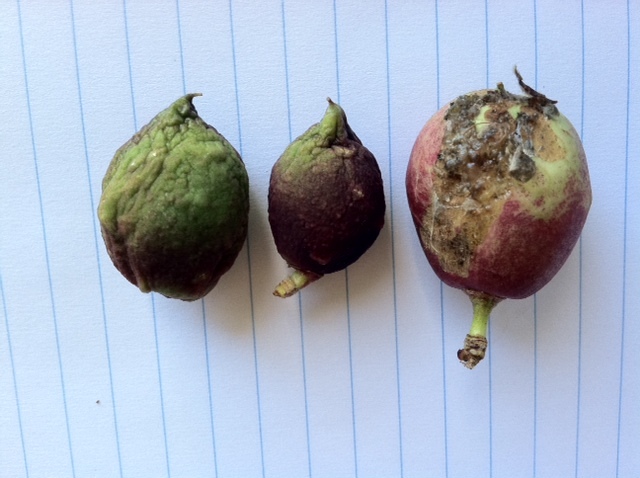Question
 nectarine fruits
nectarine fruits
our family orchard has a few nectarine trees that are about 3 years old. They all have a fair amount of fruit developing but about 20% of the fruit on one tree are small and shriveling and look desicated. They are fairly soft too whereas the larger healthier fruits are hard. There are also several large developing fruits with scarring and a gummy substance oozing out...did find one small whitish worm so I suspect oriental fruit moth ? I dont think that explains the small shriveling fruits that are dropping however and they have no signs of anything eating them. If you can tell me what you think it is, I will find a organic solution to treat it...thank you
AnswerDear Laurie, Thank you for being so patient with me. In answer to your question, you have two different problems here. The mummified fruit is due to a condition called brown rot. The most important thing to do is to remove and destroy all affected fruit immediately. I have actually copied this next bit from a place called GreenShare factsheets, by the University of Rhode Island Landscape Horticulture Program because it has such a good discussion on brown rot and how to treat it. Brown rot is a common disease of peach and other stone fruits (plum, nectarine, apricot and cherry). The brown rot fungus may attack blossoms, fruit, spurs (flower and fruit-bearing twigs) and small branches. The disease is most important on fruits just before ripening and during and after harvest. Under favorable conditions for disease development, an entire crop can be completely rotted on the tree. Symptoms first appear in the spring as the blossoms open. Diseased flowers wilt and turn brown, and are often covered with masses of brownish-gray spores. The diseased flowers usually remain attached into the summer. Fruits become more susceptible to attack as they mature, even in the absence of wounds. Fruit infections appear as soft brown spots, which rapidly expand and produce a tan powdery mass. The entire fruit rots rapidly, then dries and shrinks into a wrinkled "mummy." Rotted fruit and mummies may remain on the tree or fall to the ground. Fruit infection may spread rapidly, especially if environmental conditions are favorable and fruits are touching one another. A canker may form encircling the twig, causing death of the twig beyond the canker (twig blight). The brown rot fungus survives the winter in mummified fruits (either on the ground or still on the tree) and in twig and branch cankers produced the preceding year. Both sources may produce spores that can infect blossoms and young shoots. At about blossom time, a mummified fruit that has fallen on the ground produces up to 20 or more small, tan, cup-like structures on slender stalks that are called apothecia. At this stage, the slightest disturbance or air movement will cause an apothecium to forcibly discharge millions of spores. These spores are carried by wind to the open or unopened blossoms and young shoots. If a film of water (either from dew or rain) is present for 5 hours or longer, the spores can germinate and penetrate the plant. Following spring and summer rainy periods, mummified fruit still hanging in the tree become covered with masses of conidia that may result in blossom blight or fruit rot. Growers must realize that brown rot spores are practically everywhere during the fruit-ripening period. Infection is almost certain to occur if the weather is moist and if the fruit skin is broken in some way (especially by bugs feeding on the fruit).
1. Sanitation is very important in controlling brown rot. All dropped and rotted fruit should be picked up and destroyed promptly. At the same time, remove all mummies from the trees. Prune out all cankers during the dormant season. Overripe or rotting fruit in the packing shed should be removed and destroyed at once.
2. Control of insects that feed on fruit is essential. Remember that anything that causes wounding of the fruit will increase the incidence of brown rot. Special care should be taken during harvesting and packing to prevent puncturing or bruising of ripe fruit.
3. Remove wild or neglected stone fruit (peach, cherry, nectarine, wild plum) trees that serve as reservoirs for the disease.
4. Fruit should be cooled and refrigerated (as close to 32 degrees F as possible) immediately after harvest.
5. The use of fungicide is an important part of the disease management program for brown rot.
Use Neem (an organic chemical to control the brown rot. Spray twice in a week to control the brown rot after you have cleaned up all the possible areas of infection ?fruit, leaves and stems on ground, infected branches, and anything else suspicious and that should control future outbreaks.
Now the worms probably are oriental fruit moths. If the caterpillars are attacking fruit from the outside then you can spray the tree now with Spinosad. Spinosad is an organic product that kills only bad bugs that eating on your plants. They won't bother any bugs that are feeding on those bugs. In other words, it would kill aphids which are sucking juices out of your plants, but not the ladybugs that feed on them. You can spray the entire tree with this. You should also call your local county Extension service for a complete spraying schedule. They have been using organic control methods lately, although interestingly the spraying schedule for apples is now completely organic, but the peach/nectarine schedule, at least in most areas, didn't seem to be updated yet to strictly organic, but maybe by next year it will be.
I hope this information helps and makes sense. Please let me know if there is anything confusing or that you didn't understand, and I promise to write you back immediately. Once again thanks for being so patient with me. Good luck, Melissa






